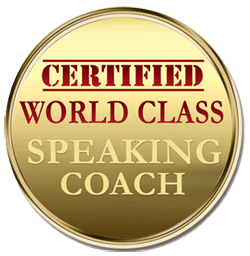Because World Class Speaking is about action, take a moment to do the following activity and find out where you stand as world class speaker.
For each competency, rate yourself from 1 to 10. Give yourself a 1 if you are very poor at the competency, and give yourself a 10 if you are great at it. Chances are you will fall somewhere in between.
Also, this is not a wish list. In other words, don’t rate how you wish you were. Rate how you currently are. It just might open your eyes to an area you need to improve. Ready? Let’s go.
- Storytelling. Bill Gove, the first president of the National Speakers Association, said that the essence of public speaking is being able to “Tell a story and make a point.” To be a World Class Speaker, you must become a world-class storyteller. On a scale from 1 to 10, how well do you feel you use stories to keep your audience on the edge of their seats and to illustrate your points?
- Selling. Every presentation is selling something, whether it is an idea, product, or service,or it’s simply getting your audience to understand the benefit of listening to your message. World Class Speakers embrace this and integrate proven selling tools into every message. Their audiences know what’s in it for them to follow the speaker’s advice. How well do you feel you sell your idea, product, service, or message?
- Process driven. We always tell speakers, “When you lift yourself up, you let your audience down.”Instead of selling your audience on how great you are (which is what lots of speakers do), you can sell them on how great your process, or formula, or recipe is.
- Next steps. World Class Speakers have one exact, defined next step they get their audiences to take immediately following their presentation. They build their entire speech around getting their audiences to take that specific next step. This next step should involve you in some way.
- Anchor driven. We have a saying that “What’s loose is lost.” This means that what’s not tied to an anchor gets forgotten by your audience. Anchors are whatever helps your audience remember your message. How well do you use anchors (stories, analogies, activities, acronyms, visuals, etc.) to illustrate each point you make and make it memorable?
- Begin with a bang. Did you know your audience members will decide whether or not they like you within the first 7 seconds of your speech? Within the first 30 seconds, they’ll decide whether or not they want to hear more. Most speakers open with a whimper. World Class Speakers open with a bang. How well do you use the first 30 seconds of your speech to make the audience thirst for more?
- Succinct. One of the biggest problems we see with presenters is that too many speakers try to get across too much information in too little time. The old speaker proverb states, “When you squeeze your information in, you squeeze your audience out.” I tell speakers, “You can’t rush and resonate.” How well do you get your information across in a tightly focused and succinct way?
- You focused. World Class Speakers know that it is never about what they give, but what the audience gets. Therefore, instead of saying, “I would like to share with you three ideas…” they say, “You’re about to receive three ideas…” The focus is always on “you” (the audience). How “you focused” is your message?
- Dynamic. Legendary speech coaches,Patricia Fripp, says, “The enemy of a speaker is sameness.” This was a revelation to me, because I thought if you’re always at the highest level of energy, and you’re using vocal variety throughout the entire speech, that’s being dynamic. Guess what? Even that gets tiring. That’s sameness! On a scale from 1 to 10, how truly dynamic are you in your delivery?
- Involvement. World Class Speakers constantly get and keep their audiences involved from the beginning to the end of their presentations. They realize that people buy into what they help create and making their audience part of the process helps to sell their message. How well do you keep your audiences involved all the way through your speeches?
- Staging. Audience members remember what they see when you speak.Many speakers are so concerned with what they plan to say that they neglect to pay attention to what the audience will see. There are many ways to use the stage to clarify your message. How well do you move with a purpose and physically use the stage to increase the impact and clarity of your presentation?
- Research/assessment. World Class Speakers meet their audiences where they are by doing pre-speech research and by assessing the energy of the audience throughout the speech. They find the pain and turn that pain into their promise. How diligently do you research your audience before you present to them?
Here comes the magical part. As you measure and strengthen each of these competencies, you will automatically find yourself speaking at a much higher level, making a much deeper impact, and attracting much more lucrative opportunities. There’s magic in these speaking muscles, as long as you build them.
WORLD CLASS SPEAKING COACH CERTIFICATION PROGRAM
STARTING OCTOBER 15 OFFERED ONCE A YEAR
Click Here To Get the Full Story

This content is excerpted from the World Class Speaking Coach Certification Program by Craig Valentine and Mitch Meyerson. If you’d like to use this material with your clients, work with Craig and Mitch for 90 days and become a Certified World Class Speaking Coach
